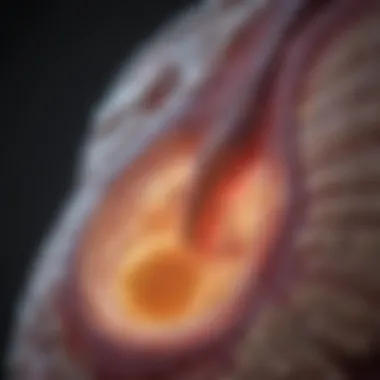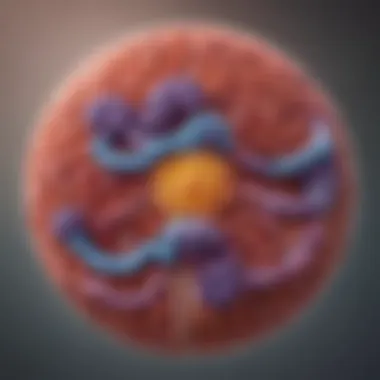The Endocrine Functions of the Pancreas Explained


Intro
The pancreas plays a pivotal role in the body's endocrine landscape, primarily through the hormones it produces. Often seen as a modest organ nestled behind the stomach, its impact on overall health is substantial and far-reaching. By exploring the various hormones secreted by the pancreas, like insulin and glucagon, we can gain valuable insights into how our metabolism is finely tuned and regulated.
In this discussion, we'll examine how the pancreas contributes to maintaining metabolic equilibrium and the far-reaching implications of its dysfunction. For students and professionals alike, understanding the endocrine functions of this organ is vital, as it links closely to various metabolic diseases and conditions seen in clinical practice.
Moreover, the latest advancements in research shed light on potential therapeutic strategies, opening doors for innovative treatment options. This journey of discovery aims to instill a deeper appreciation for the endocrine system and the pancreas's critical role within it.
Preamble to the Pancreas and Its Dual Functions
The pancreas is a fascinating organ that plays a crucial role in both the digestive system and the endocrine system. Understanding its dual functions not only sheds light on its anatomical structure and physiological processes but also highlights the significance of maintaining its health for overall metabolic balance. The endocrine functions of the pancreas, which primarily involve hormone production and regulation, are vital in managing blood sugar levels and other metabolic activities vital for life.
In this section, we'll explore why studying the pancreas is essential for a thorough grasp of human health. The interplay between the pancreas' exocrine and endocrine roles creates a complex web of biological functions. Notably, the nuances of this balance can unravel the mysteries behind various diseases, especially diabetes. Thus, comprehending how the pancreas operates is key for students, researchers, and health professionals eager to delve into endocrine functions and their broader implications on health.
Anatomical Overview of the Pancreas
To appreciate the pancreas's role in endocrine functions, one must start with its anatomical structure. The pancreas is a soft, elongated gland located in the abdomen, nestled between the stomach and the intestine. Despite its modest size, it consists of several important regions:
- Head: The bulbous part that connects to the duodenum.
- Body: The central part, which is more tapered.
- Tail: The section that extends towards the spleen.
Moreover, the pancreas is composed of both glandular tissues that secrete digestive enzymes (the exocrine function) and clusters of cells known as the islets of Langerhans, which carry out the endocrine function.
The islets make up only a small fraction of the pancreatic mass yet play an outsized role in regulating blood glucose levels. They include several types of cells, each with specific functions that collectively manage the body’s hormonal milieu.
Endocrine vs. Exocrine Functions
The polarization of functions in the pancreas is a remarkable aspect that warrants in-depth analysis. The pancreas has both endocrine and exocrine functions, each serving unique but interrelated purposes.
Exocrine Functions
In its exocrine capacity, the pancreas produces digestive enzymes, such as:
- Amylase: Breaks down carbohydrates.
- Lipase: Helps digest fats.
- Proteases: Responsible for protein breakdown.
These enzymes are secreted into the small intestine to facilitate digestion. Essentially, without these enzymes, nutrient absorption would be severely hampered.
Endocrine Functions
Conversely, the endocrine functions are primarily centered within the islets of Langerhans. Hormones produced by these cells include:
- Insulin: Lowers blood glucose levels, promoting glucose uptake by cells.
- Glucagon: Raises blood glucose levels by stimulating glycogen breakdown in the liver.
- Somatostatin: Inhibits both insulin and glucagon, allowing fine-tuning of hormone release.
- Pancreatic Polypeptide: Regulates both exocrine and endocrine functions of the pancreas.
The pancreas plays a dual role: its exocrine function aids digestion, while the endocrine function directly impacts metabolic regulation. Understanding this duality is fundamental for anyone studying endocrinology.
The Pancreatic Islets: Structure and Composition
The pancreatic islets, or islets of Langerhans, play a pivotal role in the endocrine functions of the pancreas, linking hormonal control to metabolic processes. These tiny clusters of cells, making up only about 1-2% of total pancreatic mass, are vital in regulating blood glucose levels as well as other metabolic functions. Understanding the structure and composition of these islets allows for deeper insight into how they're involved in diseases like diabetes and other endocrine disorders.
Types of Islet Cells
The islets consist of several types of cells, each with distinct functions that contribute to the overall regulatory capacity of the endocrine pancreas. Let’s take a closer look at each cell type and what sets them apart in their roles:


Alpha Cells
Alpha cells are responsible for producing glucagon, a hormone that plays a critical role in raising blood sugar levels during hypoglycemia. One striking aspect of alpha cells is their ability to respond instantly to dropping glucose. This rapid secretion helps prevent dangerous drops in blood sugar, highlighting their protective role in our metabolism. The unique feature of alpha cells is their direct communication with beta cells, allowing for fine-tuned hormonal balance. This synergy, while advantageous, can also be a double-edged sword in certain conditions where glucagon release becomes excessive, leading to hyperglycemia.
Beta Cells
Beta cells are probably the most well-known type of islet cell due to their role in insulin production. Their ability to synthesize insulin and release it in response to rising glucose levels is fundamental in maintaining homeostasis. A key characteristic of beta cells is their intricate networks that facilitate communication within the islets. Their efficiency is crucial, though their dysfunction is a hallmark of diabetes type 1 and type 2. Notably, beta cells have a fascinating regenerative capacity, which some research is currently exploring as a potential avenue for diabetes treatment.
Delta Cells
Delta cells produce somatostatin, a hormone that inhibits various functions, including the secretion of both insulin and glucagon. A unique aspect of delta cells is their role in providing feedback to alpha and beta cells to maintain balance in hormone levels. Their relatively small proportion in the islets doesn’t downplay their influence; without somatostatin, the hormonal regulation could become erratic. In some instances, insufficient activity of these cells has been linked to metabolic disorders, showcasing their significance.
PP Cells
Finally, PP cells manufacture pancreatic polypeptide which regulates both the endocrine and exocrine functions of the pancreas. The key characteristic of PP cells is their responsive nature to feeding states, where they help modulate gastric motility and appetite. This response can be advantageous for understanding eating behaviors and metabolic health. However, an imbalance in PP levels may contribute to digestive issues, signaling the need for further investigation.
Islet Cell Distribution and Architecture
The distribution of islet cells within the pancreatic architecture plays a significant role in their functionality. Generally, beta cells are prominently located in the central region of the islets, surrounded by alpha and delta cells at the periphery. This peculiar arrangement allows for coordinated responses to changes in blood glucose levels, facilitating immediate feedback between the different cell types. The diversity of cell types within a compact space makes it an efficient system for hormonal regulation.
Understanding the structure and composition of the pancreatic islets serves not just academic interest but has real-world implications for addressing metabolic diseases. As research progresses, clarifying these cellular interactions may pave the way for innovative treatments that could vastly improve health outcomes.
Hormonal Regulation and Biochemistry
Understanding hormonal regulation and biochemistry is pivotal in grasping how the pancreas influences our metabolism. This function orchestrates various biochemical processes, ensuring that hormone secretion aligns with our body’s metabolic needs. The fine-tuning of insulin, glucagon, and other hormones allows for responsiveness to dietary intake and energy expenditure, making it crucial not just for maintaining homeostasis but also for preventing pathological states such as diabetes.
Insulin: Synthesis and Secretion Mechanisms
Insulin is a key player in metabolic control, synthesized predominantly in the beta cells of the pancreatic islets. It’s like the gatekeeper of glucose levels, enabling cells to take up glucose effectively when there is an abundance, such as after a meal. The synthesis begins with the translation of preproinsulin mRNA, which undergoes post-translational modifications to produce proinsulin. This proinsulin is then cleaved into insulin and C-peptide, with insulin being stored in secretory granules.
When glucose levels rise, such as following carbohydrate ingestion, the beta cells respond rapidly. Glucose enters these cells via the glucose transporter GLU4. This influx triggers a series of cellular events including the closure of ATP-sensitive potassium channels, leading to depolarization and calcium influx. The result? A swift release of insulin into the bloodstream, ready to help usher glucose into the cells where it's needed.
Glucagon: Its Role and Function
Glucagon, a counterbalance to insulin, plays an equally vital role in blood glucose regulation. Secreted by the alpha cells of the islets, this hormone kicks into gear when glucose levels drop, for example, during fasting or intense physical activity. Its primary action is to stimulate the liver to release stored glucose, specifically through hepatic glycogenolysis and gluconeogenesis.
In simple terms, glucagon tells the liver, "Hey, we need some fuel!" The liver responds by either breaking down glycogen into glucose or forming new glucose molecules. This push is crucial for maintaining blood sugar levels, especially when one isn’t eating. The dance between glucagon and insulin is a delicate balancing act that ensures our bodies have the energy they need at all times.
Other Hormones of the Islets
Beyond insulin and glucagon, the pancreatic islets harbor other important hormones like somatostatin and pancreatic polypeptide, which expand our understanding of metabolic regulation.
Somatostatin
Somatostatin, secreted by delta cells, serves as an important regulator of the endocrine system by inhibiting the secretion of both insulin and glucagon. Think of it as the brake pedal in this hormone-driven engine. Its production increases in response to elevated nutrient levels in the blood, thus helping keep the activities of insulin and glucagon in check.
This balancing act is essential; without somatostatin, the body could easily swing into states of hyperglycemia or hypoglycemia. It’s a fine example of how one hormone can modulate the actions of others, ensuring that metabolic processes are coordinated and effective.
Pancreatic Polypeptide
Pancreatic polypeptide, released from the PP cells, garners attention for its role in modulating the exocrine functions of the pancreas and influencing digestive processes. Its secretion is stimulated by food intake, particularly protein-rich meals, and it has been shown to decrease appetite and inhibit pancreatic secretion of enzymes.


While its functions are less understood compared to insulin and glucagon, it represents an intriguing area of study. Its unique feature lies in its potential appetite-regulating properties, which may contribute to understanding obesity and metabolic disorders. The intricacies surrounding pancreatic polypeptide beckon further exploration, particularly in clinical and therapeutic contexts.
Understanding the roles and interactions of these hormones provides vital insights into metabolic health and disease.
These various hormones underscore the complex interplay required for maintaining metabolic homeostasis. When considering the overarching topic of how the pancreas regulates endocrine functions, examining these distinct but interconnected hormones paints a comprehensive picture of endocrine dynamics.
Mechanisms of Hormonal Regulation
Understanding the mechanisms behind hormonal regulation in the pancreas provides crucial insights into how this vital organ maintains homeostasis. Hormones such as insulin and glucagon play dominant roles in regulating blood glucose levels, while other hormones contribute to various metabolic processes.
The intricate feedback loops and responses to nutrient availability are paramount to metabolic balance. A comprehensive grasp of these mechanisms allows for better insights into health conditions like diabetes and offers avenues for innovative treatments.
Glucose Homeostasis: The Feedback Loop
The human body thrives on a finely tuned balance, especially when it comes to blood glucose levels. The pancreas is at the center of this dance, effectively sensing changes and adjusting hormone secretion accordingly. At the core of glucose homeostasis is a feedback loop, primarily involving insulin and glucagon.
- When blood glucose levels rise, for instance after a meal, beta cells in the islets of Langerhans release insulin. This hormone facilitates the uptake of glucose by cells, effectively lowering blood sugar.
- Conversely, when glucose levels drop, such during fasting, alpha cells kick in, releasing glucagon. This prompts the liver to convert glycogen back into glucose, raising blood sugar levels once again.
The dynamic interaction between these hormones exemplifies a negative feedback mechanism, ensuring that blood glucose levels remain within a prudent range. Here’s how it typically unfolds:
- Elevated blood glucose -> Insulin secretion
- Increased cellular glucose uptake
- Decreased blood glucose levels
- Reduction in insulin secretion
- Simultaneously, low blood glucose levels initiate glucagon release.
"A healthy feedback loop is akin to a well-oiled machine; every component must work in harmony to avoid dysfunction."
This feedback system not only emphasizes the pancreas' role but also highlights the importance of consistent monitoring of blood sugar levels for diabetic patients.
Influence of Nutrient Levels on Hormone Secretion
The levels of various nutrients directly influence how the pancreas functions, particularly concerning hormone secretion. The relationship between nutrient intake and hormone response cannot be overstated.
- Carbohydrates trigger the most notable response. When carbohydrates are consumed, blood glucose levels rise, stimulating insulin secretion immediately.
- Proteins possess a dual action. Though they also promote insulin release, they influence glucagon secretion as well. Amino acids from digested proteins provide the building blocks for both hormone responses.
- Fats affect hormone secretion too, but their role is somewhat less direct. High fat levels can lead to increased insulin resistance, impacting overall glucose control.
This nutrient interaction underscores the necessity for a balanced diet. A diet lacking in certain nutrients could impair hormonal regulation, leading to complications over time. Understanding these connections can aid individuals in managing their diet effectively, particularly those seeking to improve metabolic health.
The mechanisms of hormonal regulation within the pancreas not only inform us of its direct functions but also highlight the interconnectedness of various bodily systems and the importance of maintaining a healthy lifestyle.
Pathophysiology of Pancreatic Endocrine Disorders
Understanding the pathophysiology of pancreatic endocrine disorders is crucial, as it sheds light on the mechanisms behind common metabolic diseases such as diabetes. The pancreas is a key player in glucose regulation, and any disruption in its hormonal secretions can lead to significant health issues. Furthermore, diving into the pathophysiological aspects allows researchers and healthcare professionals to develop more targeted treatments and interventions, resulting in improved patient outcomes.
The endocrine functions of the pancreas are intricate, and their disturbances can manifest in various forms. Two major types of diabetes, Type 1 and Type 2, reflect different underlying mechanisms, yet their effects on metabolism highlight how critical the pancreatic hormones—like insulin and glucagon—are in maintaining glucose homeostasis.
Type Diabetes: Immunological Aspects
Type 1 diabetes is primarily an autoimmune disorder, where the body's immune system mistakenly targets and destroys the insulin-producing beta cells in the islets of Langerhans. This destruction leads to an absolute deficiency of insulin. The disease often presents during childhood or adolescence, but it can also develop in adults. The key aspect here is the role of specific antibodies that can be detected in the blood of individuals prior to the onset of disease symptoms. These antibodies, such as GAD65 antibodies, serve as biomarkers for early detection.
By understanding the immunological underpinnings, researchers are better equipped to investigate potential therapeutic avenues, such as immunotherapy, which aims to preserve beta-cell function or induce immune tolerance.
Type Diabetes: Metabolic Considerations
On the other hand, Type 2 diabetes is characterized by insulin resistance, where the body’s cells become less responsive to insulin's effects. This often accompanies a relative deficiency in insulin secretion as the disease progresses. Factors influencing this condition include obesity, sedentary lifestyle, and genetics. The metabolic aspect of Type 2 diabetes covers alterations in lipid metabolism and chronic inflammation, which complicates the clinical picture.


Understanding these metabolic considerations is pivotal because interventions can range from lifestyle modifications to pharmacological treatments. The emphasis on weight management and physical activity can significantly improve insulin sensitivity and, in turn, control blood glucose levels.
Other Endocrine Disorders and Disruptions
Wolfram Syndrome
Wolfram Syndrome is an intriguing genetic disorder characterized by diabetes mellitus, optic atrophy, and diabetes insipidus. One of its key characteristics is the combination of endocrine and neurological symptoms, highlighting the interconnectedness of bodily systems. In this context, understanding how Wolfram Syndrome affects insulin production and overall endocrine function enriches the discourse in this article. A unique feature of this syndrome is its early onset of diabetes, typically before the age of 20, bringing attention to the role of genetics in endocrine disorders.
This syndrome is particularly illustrative for this article, as it emphasizes the need for comprehensive evaluation in patients with unexplained diabetes, especially when accompanied by other symptoms like vision problems.
Schmidt Syndrome
Schmidt Syndrome, although less common, illustrates another facet of endocrine disorders affecting the pancreas. This syndrome is marked by autoimmune adrenal insufficiency and associated thyroid dysfunction. A notable characteristic is that it can co-occur with diabetes, resulting in a polyendocrine disorder with complex management requirements.
Its unique feature revolves around the interactions between various autoimmune responses, which can complicate treatment plans. Understanding Schmidt Syndrome and its implications enriches the narrative regarding pancreatic functions, particularly how autoimmune disorders can impact multiple endocrine systems, making it a substantial addition to discussions within this article.
Recent Research Trends in Endocrinology
As the understanding of pancreatic endocrine functions evolves, recent research trends offer a glimpse into new treatments and interventions that could reshape diabetes management and beyond. The relevance of these trends not only lies in advanced therapies but also in providing hope for improved patient outcomes. In this section, we explore key areas driving change in the field of endocrinology—from innovative treatments to future possibilities that emphasize personalized medicine.
Advancements in Diabetes Treatment
One of the most significant areas of focus in modern endocrinology involves the search for better methods to manage diabetes. Traditional treatment approaches, while effective to an extent, may not work for everyone. The response to insulin can vary widely among patients, prompting researchers to explore alternative avenues.
- Continuous Glucose Monitors (CGMs): These devices are now making it possible for patients to track their blood glucose levels in real-time, facilitating timely interventions. It’s like having a little helper on your wrist or pocket, always watching over your glucose.
- Smart Insulin Pens: This new tech adapts insulin doses based on predicted blood sugar levels, making it a personalized alternative to standard insulin methods.
Research is increasingly targeting the biological mechanisms that underpin diabetes. Studies focusing on the gut microbiome—bacteria residing in the digestive tract—are revealing how these microorganisms influence insulin sensitivity and glucose metabolism. Findings suggest that modifying gut flora may enhance treatment efficacy.
Gene Therapy Approaches
Gene therapy is becoming a beacon of hope for many battling endocrine disorders, particularly diabetes. Essentially, it involves altering genes to treat or prevent disease. This could revolutionize how we think about diabetes management. Imagine a future where a one-time genetic treatment may prevent diabetes from developing altogether.
- CRISPR Technology: Its ability to edit genes has opened doors for potentially correcting genetic defects responsible for diseases. This could directly impact Type 1 diabetes where autoimmunity destroys insulin-producing cells.
- Gene Delivery Systems: Advanced delivery systems like viral vectors are being studied for effectively sending therapeutic genes right where they’re needed, which is critical for maximizing the impact of any gene therapy intervention.
Gene therapy is a promising field but comes with its own set of challenges, including safety and ethical considerations. Still, ongoing research aims to tackle these issues, potentially leading to groundbreaking outcomes in managing pancreatic disorders.
Pancreatic Transplantation Perspectives
Pancreatic transplantation is an aggressive yet potentially life-changing approach for individuals with severe diabetes, particularly Type 1. This procedure can restore insulin production and greatly improve quality of life. Recent developments in this area have begun to pave new pathways.
- Living Donor Transplants: There has been exciting progress in identifying living organ donors, which helps alleviate some pressure on deceased donor waiting lists and makes it more feasible for patients to receive this necessary surgery.
- Islet Cell Transplantation: Instead of transplanting an entire pancreas, transplanting just the islet cells has gained traction. This method can be less invasive and has fewer complications.
However, the surgery does come with risks, and not everyone is a candidate. Research continues to refine patient selection criteria and improve post-transplant care, ensuring that transplanted organs thrive and function effectively.
"As we dive deeper into the realm of pancreatic functions, the studies highlight that exploration and innovation are key to transforming diabetes care."
In summary, the recent trends in endocrinology related to pancreatic functions signify that change is on the horizon. The potential of advancements in diabetes treatment, gene therapy, and pancreatic transplantation not only holds promise for better health outcomes but also emphasizes the importance of continued research in this vital field.
Culmination
Understanding the pancreatic endocrine functions is no small feat, but it's certainly a vital endeavor. This section encapsulates the significance of what we’ve explored—hormones and their roles in sustaining metabolic equilibrium and health. Among the key elements to consider is the intricate balance maintained by the pancreas, orchestrating the release of insulin, glucagon, and other hormones. This balance is not merely academic; it holds immense practical implications for health professionals, students, and researchers who aim to tackle metabolic disorders.
The benefits of diving deep into the functional dynamics of the pancreas are manifold. First and foremost, grasping these processes allows for better comprehension of how disruptions can lead to serious conditions like diabetes and other metabolic disorders. With the prevalence of such conditions soaring, knowledge of the endocrine functions of the pancreas is increasingly crucial. Armed with this understanding, practitioners can engage in more informed conversations around diagnosis and treatment options.
Furthermore, acknowledging the recent advancements in research leads to promising avenues in treatment modalities. For instance, innovative gene therapy and pancreatic transplantation are just a couple of shining examples of how our increasing understanding can evolve into practical solutions. There lies a clear connection between understanding the pancreas's functions and the development of effective therapeutic strategies.
"The greater understanding of pancreatic hormone regulation directly correlates with advancements in treatment for a myriad of conditions, making this knowledge not just significant but imperative."
Thus, by grasping the complexities of pancreatic hormones, we equip ourselves with the tools to foster improvements in health care strategies, ensuring we are not merely spectators but active participants in addressing critical health challenges. Ultimately, the insights drawn from this topic foster a more nuanced perspective of how we view metabolic health, demonstrating that the pancreas is deserving of our attention.



